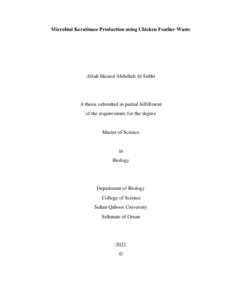Document
Microbial keratinase production using chicken feather waste.
Publisher
Sultan Qaboos University.
Gregorian
2022
Language
English
English abstract
Chicken feathers are one of the greatest sources of keratin. These wastes, on the other
hand, can be converted into valuable resources. This current study was conducted to
valorize these keratinized wastes to produce microbial keratinase, using the microbes
present on feathers. 15 keratinolytic bacterial strains and 15 keratinolytic fungal strains
were isolated. Among the isolates from the feathers, Aeromonas caviae was identified as
an efficient keratinase producer. This bacterium showed high efficiency in feather
degradation (23 %) with a high enzyme activity of 42.59 U/mL at 72 h of cultivation. At
168 h of cultivation, A. caviae produced 182.5 µg/mL of soluble protein. This soluble
protein contained 18 amino acids with their derivatives including; histidine, glycine,
tryptophan, tyrosine, valine, and β-alanine, alanine, arginine, asparagine, creatine,
glutamine, glutathione, isoleucine, leucine, lysine, methionine, cystine, taurine, ornithine,
proline, and threonine. The keratinase production conditions were optimized using the
Response Surface Method. The obtained enzyme was partially purified using ammonium
sulfate precipitation and dialysis. Under optimum conditions of PH 9 and 80 °C a
keratinase activity of 48.54 U/mL was obtained. The partially purified keratinase was
characterized as a serine protease. It was activated by K+
, Mg2+, Zn2+, and Na+
, salts, and
solvents including, SDS, Triton X-100, DMSO, Isopropanol, and TWEEN 80 with a
notable increase in activity of 6-10%. H2O2, 2-Mercaptoethanol, and acetonitrile slightly
inhibited the activity of keratinase. Moreover, the results revealed the ability of obtainable
keratinase to degrade other substrates including casein, gelatin and skim milk with higher
relative activity than the control. This study showed that keratinase produced by A. caviea
isolated from chicken feathers is a promising tool for different industrial applications.
Member of
Resource URL
Arabic abstract
يعد ريش الدجاج من أكثر مصادر الكيراتين المهملة، و التي من الممكن تحويلها من مجرد نفايات إلى موارد قيمة . فقد أجريت هذه الدراسة بهدف تثمين هذه المخلفات الكيراتينية لإنتاج إنزيم الكيراتينيز الميكروبي باستخدام الميكروبات الموجودة على الريش. فقد تم عزل حوالي 15 عترة لسلالات بكتيرية و 15 عترة اخرى لسلالات فطرية لديها القدرة على تحليل الكيراتين. من بين عزولات الريش، تم التعرف على بكتيريا الايروموناس كافيا (caviae Aeromonas (ذات الفعالية العالية لإنتاج إنزيم الكيراتين. حيث اظهرت هذه البكتيريا كفاءة عالية في تحليل الريش بنسبة 23 % مع نشاط إنزيمي مرتفع نسبيا قدره 42.59 وحدة / مل خلال 72 ساعة من الزراعة الميكروبية. بينما أنتجت 182.5 ميكرو جرام / مل من البروتين السائل خلال مرور 168 ساعة من الزراعة. و قد احتوى هذا السائل البروتيني على 18 حمضا أمينيا مع بعض مشتقاتها و أشتمل على : هيستيدين، جلايسين، تريبتوفان، تيروسين، فالين، ألأنين، أرجينين، أسباراجين، كرياتين، جلوتامين، جلوتاثيون، إيسولوسين، ليسين، ميثيونين، سيستين، تورين، أورنيثين، برولين ، ثريونين. و تم تحسين ظروف إنتاج إنزيم الكيراتين باستخدام طريقة الإستجابة السطحية و الحصول على نشاط كيراتيني و قدره 48.54 وحدة / مل في ظل الظروف المثلى هي الرقم الهيدروجيني 9 و درجة حرارة 80 درجة سيليزية. بالإضافة إلى تنقية الإنزيم جزئيا باستخدام طريقة الترسيب بكبريتات الأمونيوم . في حين صنف إنزيم الكيراتين المنقى جزئيا ضمن الإنزيمات المعدنية المحللة للبروتين. و قد تأثر الإنزيم ببعض المحفزات الكيميائية و الأملاح بما في ذلك أيونات الماغنيسسوم و الصوديوم و الزنك و أحد المشتات غير الأيونية )-100X Triton )وثنائي ميثيل سلفوكسيد و كحول إيزوبروبانول و دوديسيل كبريتات الصوديوم و مادة عديد السوربات المسجلة تجاريا باسم )80 Tween)،مع زيادة ملحوظة للنشاط الإنزيمي بنسة 6 – 10 ،% بينما تثبط نشاط الانزيم بشكل طفيف عند معاملته بالمواد التالية: الاسيتونيترل و -2مركابتوإيثانول و بيروكسيد الهيدروجين، و قد أظهرت هذه الدراسة أن إنزيم الكيراتين الذي تنتجه هذه البكتيريا مفيد لتطبيقات صناعية واعده
Category
Theses and Dissertations

